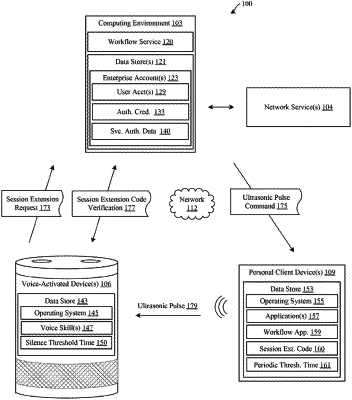| CPC H04L 63/0861 (2013.01) [G10L 17/00 (2013.01); H04L 9/085 (2013.01); H04L 9/3231 (2013.01)] | 20 Claims |

|
1. A system, comprising:
at least one computing device comprising at least one processor; and
at least one memory comprising executable instructions, wherein the instructions, when executed by the at least one processor, cause the at least one computing device to at least:
receive, by a workflow service executed by at least one server device, a session extension request from a voice skill on a voice-activated device to extend a voice skill session of the voice-activated device;
identify, by the workflow service, a personal client device based on the session extension request;
transmit, by the workflow service to the personal client device, a command comprising instructions that instruct a workflow application executed by the personal client device to:
generate a session extension code using an expected code generation algorithm expected by the workflow service; and
periodically emit an ultrasonic pulse to extend the voice skill session of the voice-activated device at a specified time period, wherein the specified time period is selected to be shorter than a security time period of an operating system of the voice-activated device, the ultrasonic pulse comprising the session extension code to be extracted by the voice skill on the activated voice-activated device;
receive, by the workflow service from the voice-activated device, the session extension code extracted from the ultrasonic pulse by the voice-activated device;
identify a verification status based on determining that the session extension code is generated using the expected code generation algorithm; and
perform, by the workflow service, an action based on the identified verification status.
|